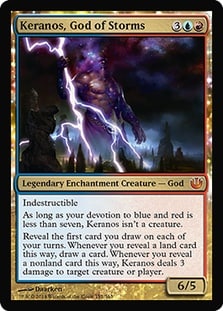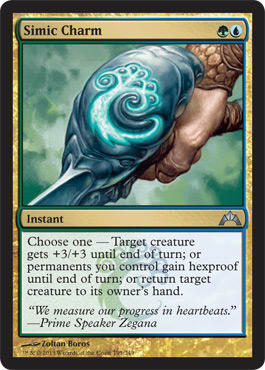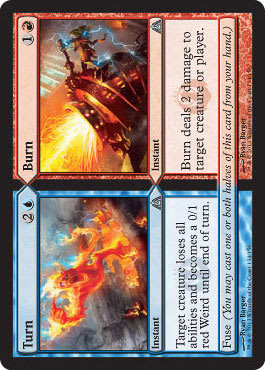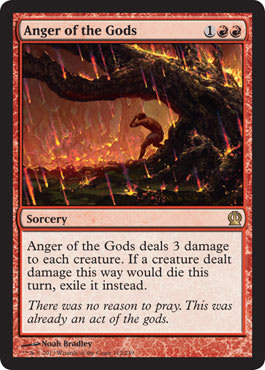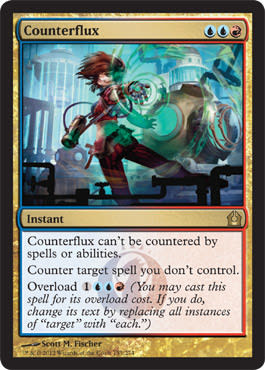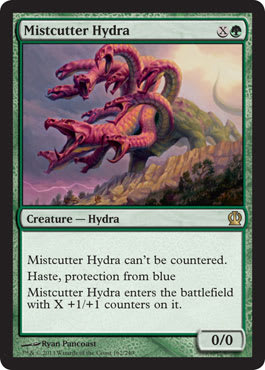Is Standard finally evolving?
Another week of it has passed, and the most recent StarCityGames Open (Knoxville) showed some interesting results in the Top 16. There was a mix of Jund Monsters, W/U/x Control, Junk Midrange, Naya Aggro, B/g Devotion, and, surprisingly, Boros Burn taking first place.
In my last article, I mentioned the format possibly speeding up thanks to cards such as Mana Confluence, and that seems to be the case. Almost half the decks in the Top 16 were running the City of Brass look-a-like, and even though not all of them were aggro decks, there were still more than usual in the Top 16.
Similar to my Enchanted Junk deck I showcased in my last article, I wanted a deck that could stand up to these aggressive strategies. That being said, I wanted something that had a bit more power behind it and that was more viable against a wider range of decks.
Prior to SCG Knoxville, I began working on a deck that featured Keranos, God of Storms after challenging myself to implement him in a non-control list. After watching some of the feature matches and looking at the Top 16 list, I adjusted the deck, and I’m now more comfortable with how it looks.
Here is what I came up with:
R/U/G Bounce ? Journey into Nyx Standard | Michael Yee
- Creatures (20)
- 2 Prophet of Kruphix
- 3 Stormbreath Dragon
- 4 Courser of Kruphix
- 4 Frostburn Weird
- 4 Sylvan Caryatid
- 1 Niv-Mizzet, Dracogenius
- 2 Keranos, God of Storms
- Planeswalkers (3)
- 1 Kiora, the Crashing Wave
- 2 Jace, Architect of Thought
- Spells (13)
- 1 Aetherize
- 1 Voyage's End
- 2 Izzet Charm
- 2 Simic Charm
- 2 Turn // Burn
- 3 Mizzium Mortars
- 2 Cyclonic Rift
- Lands (24)
- 1 Forest
- 1 Island
- 2 Mana Confluence
- 4 Breeding Pool
- 4 Steam Vents
- 4 Stomping Ground
- 4 Temple of Abandon
- 4 Temple of Epiphany
- Sideboard (15)
- 4 Mistcutter Hydra
- 2 Anger of the Gods
- 2 Counterflux
- 2 Scavenging Ooze
- 2 Unravel the Aether
- 2 Swan Song
- 1 Cyclonic Rift
This is a R/U/G Midrange deck that uses efficient bounce and removal spells to out-tempo our opponent and control the pace of the game until we can start playing our Planeswalkers and other threats. Once we’re able to bring them on board, we can continue putting our opponent at a disadvantage while protecting our threats with cards like Simic Charm, enabling us to race effectively. Keranos, God of Storms gives this deck an edge by providing card advantage, an extra source of removal, and another way to deal damage.
One of the first problems I had to acknowledge was Keranos’s cost. His mana cost of
Even though Temple of Epiphany helps U/R-based decks, running only Izzet colors wasn’t something I wanted to do. So, I immediately thought of adding green because the mana dorks let us bring Keranos out sooner. More specifically, Sylvan Caryatid is my dork of choice. It’s an early, hard-to-remove blocker that can help us gain tempo by slowing the damage done to us, and it lets us play our threats sooner. It also gives us access to more mana per turn, meaning we’re able to use a greater amount than our opponent.
What else do we gain from going green?
Courser of Kruphix – Another favorite green card of mine, Courser blocks early threats for us and is able to deal some damage on an open board. However, in combination with Keranos, God of Storms, it helps us dig through our deck, meaning we can draw threats and answers earlier than our opponent. For example, if I draw a land for my turn, Keranos gives me another draw, possibly a spell. If Courser shows another land on top, we’re able to play it. This means we put a spell and a land in our hand with the bonus of going through three cards in our deck. This combination of cards also means missing land drops is less likely to happen.
Simic Charm – Probably one of the more underrated charms in Standard, all three of this Charm’s modes are important to us. We’re able to win trades and squeeze that last bit of damage in with the +3/+3 pump, protect our permanents from Detention Spheres or other targeted removal, and bounce back our opponents’ creatures to help race. The last mode can also be used on our own creatures in certain situations to protect them from things such as Elspeth, Sun's Champion’s -3 ability (for Stormbreath Dragon) or Supreme Verdict.
Prophet of Kruphix – This card has a ton of different applications in the deck since it allows us to use our turn to play threats without having to leave mana available for our opponent’s turn. Prophet can create huge tempo swings since we can cast many more spells between our turn and opponent’s turn. The ability to flash in creatures also comes in handy. For instance, we can flash in Keranos, God of Storms at the end of our opponent’s turn to gain value from him right away.
Kiora, the Crashing Wave – She provides another method of ramping, another win condition, and another way to slow down our opponent. Alongside our other Planeswalker Jace, Architect of Thought, we have the ability to lock down both aggressive decks and decks that play larger threats.
Creatures
Stormbreath Dragon – Stormbreath Dragon is among the best threats in Standard and is able to race very effectively due to the haste and evasion it provides. Thanks to Sylvan Caryatid, we bring it out earlier and activate its monstrosity earlier.
Frostburn Weird – This is a card that’s strong in both aggro matchups and control matchups. It blocks early against aggressive 1- or 2-drops, but against control, we’re able to provide pressure without overextending. The two devotion it adds for Keranos is also relevant since bringing the God online is a very possible outcome for this deck.
Niv-Mizzet, Dracogenius – Niv-Mizzet provides another way for us to attack our opponent. Not only is he a flyer, but he gives a nice outlet for unused mana. The ability to dump mana into him to draw cards helps ensure we don’t run out of threats or ways to bounce or remove our opponent’s spells. Niv-Mizzet also adds four devotion for Keranos, God of Storms, which means all we need is two more devotion to start attacking with him.
Keranos, God of Storms – When we’re bouncing spells back to our opponent’s hand, Keranos gives us a way to start gaining advantage. Free Lightning Bolts or drawing extra cards are both great outcomes for this deck. The nice thing about the free Lightning Bolts is they’re not restricted to targeting players, meaning Keranos can provide another source of removal for us if we need it. Our permanents also bring enough devotion to the table to bring him online, so having a 6/5 indestructible onboard is also a possibility.
Noncreature Spells
It was tough to decide what kind of noncreature spells I wanted. Originally, I had cards such as Frost Breath combined with Battlefield Thaumaturge to make them even more efficient. However, that combination proved to be too weak, and very rarely did it give me the tempo advantage I needed to overtake my opponent.
I settled on a wide variety of spells that all did something similar but that allowed us to attack different decks from different angles. I adjusted to seeing more Naya Aggro decks being played, and I found bounce spells work very well against their trying to have a one-turn kill with Boros Charm and Ghor-Clan Rampager.
Mizzium Mortars – With Sylvan Caryatids, we have the potential to overload as early as turn four, but otherwise, it’s a cheap removal spell for a wide range of creatures.
Cyclonic Rift – Similar to Mizzium Mortars, Cyclonic Rift can be played early on for a quick bump in tempo or overloaded to be a blowout. Many decks tap out or come close to tapping out for their turns in order to play big spells such as Desecration Demon or Elspeth, Sun's Champion. With the Rift, we can bounce it back at the end of the opponent’s turn, effectively resetting his or her turn with the benefit of having the player be tapped out for our turn.
Izzet Charm – This card helps slow our opponent down, whether it’s removing his or her early threats or mana dorks or countering a noncreature spell such as a Planeswalker. Since the deck has quite a few reactive spells, it also can help in difficult situations in which we’re searching for something specific.
Turn // Burn – This is a card that hits almost everything in Standard and is something we can use as a combat trick by turning the opponent’s attacker into a 0/1 Weird for the turn. Both sides can be used separately—or, if we need to just take out one large threat, we can fuse.
Voyage's End – When decks like R/U/G Bounce rely on a varied set of spells, I like having one-ofs. Voyage's End only hits creatures, but the scry is quite nice, and unlike Cyclonic Rift, we can save our own creatures with it if we choose to.
Planeswalkers were something I never considered in my first iterations of the deck. However, both Jace, Architect of Thought and Kiora, the Crashing Wave work well in this deck. Thanks to Courser of Kruphix and Keranos, God of Storms, we’re already digging through our deck fairly quickly. Jace and Kiora can help with that, but they also provide another layer of protection against multiple decks. An added bonus is that they both provide some devotion for Keranos.
Matchups
Naya Aggro
Out:
In:
Take out some top-end cards to ensure we can bring in more utility. Anger of the Gods hits everything except Loxodon Smiter, while Mizzium Mortars can hit the rest. Swan Song can counter Boros Charms, Selesnya Charms, and Brave the Elements since we don’t care about a 2/2 flyer in this deck. If Fleecemane Lion ends up monstrous, we can hold onto Aetherize to reset it.
Boros Burn
Out:
In:
Just an old-fashioned damage race, this matchup is about preventing as much damage to us while maximizing damage to the opponent. Being able to ramp into our large threats, we should have no problem dealing with enough threats to survive till then thanks to our counters and removal, and Courser of Kruphix can help sustain our life.
B/g Devotion
Out:
In:
Our main deck is fine against B/g Devotion since Abrupt Decay and Golgari Charm aren’t as good against us compared to other decks, so the main thing we need to worry about is Underworld Connections, meaning Unravel the Aether is necessary. Jace doesn’t do much for us here and usually ends up just dying to Hero's Downfall. Kiora can stay in due to her ability to lock down Desecration Demon and Lifebane Zombie more effectively. Aetherize works fairly well against Pack Rat tokens since we’re able to let the opponent discard important spells before pulling the trigger on it, and it’s even better if we catch a Mutavault in the attack.
W/U/x Control
Out:
4 Sylvan Caryatid
In:
Mistcutter Hydra and Stormbreath Dragon are our heavy hitters in this matchup with Kiora’s ultimate as another possible win condition. Swan Song and Counterflux are brought in to take care of Sphinx's Revelation or any other spell we can’t have hitting the field, and Unravel the Aether frees up our permanents from Detention Sphere and Banishing Light. I like to leave one Mizzium Mortars in since opponents sometimes bring in cards such as Brimaz, King of Oreskos or Archangel of Thune.
Monsters
I found the Monsters matchup to be quite favorable for us, and I don’t have a set sideboard plan for this deck since the main deck is generally well-situated for it. However, the sideboard contains a nice range of tools to deal with unique versions of the deck should they arise.
Overall, I’m quite satisfied with the deck, and if you want to play something that’s a bit more on the unique side, this deck’s for you!
- Michael Y.













